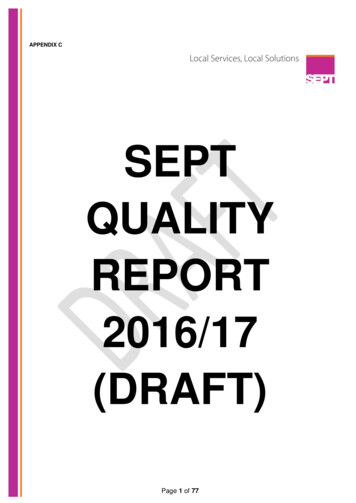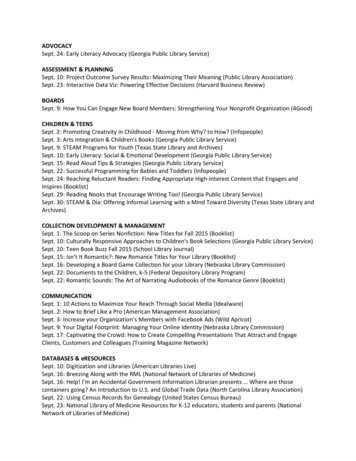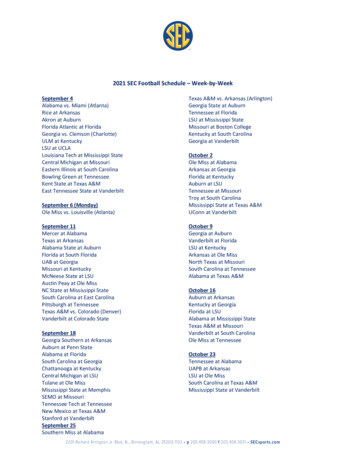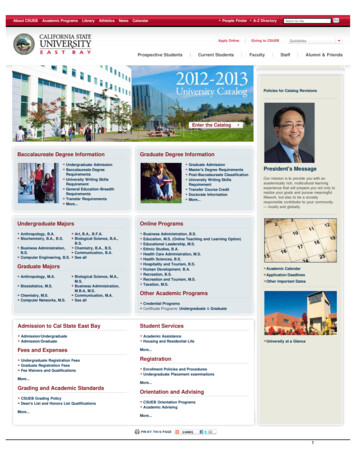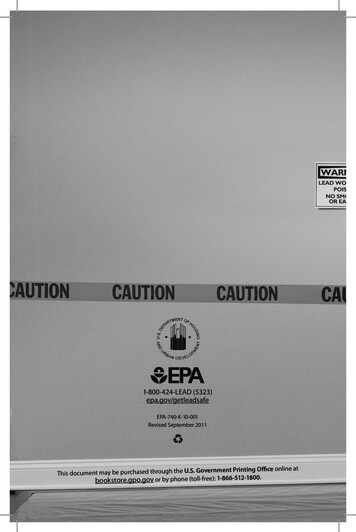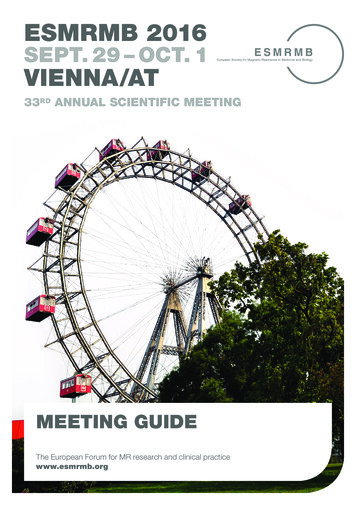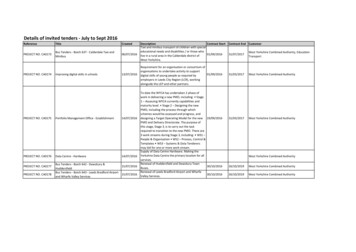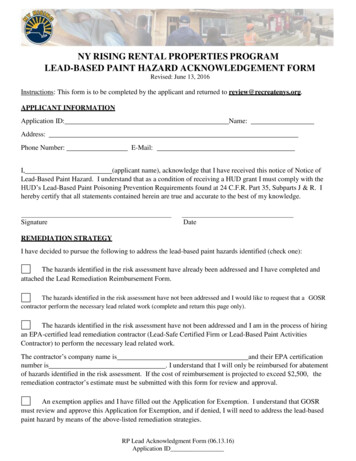
Transcription
Sept 2016Lead/Authors: Avichal Mehra (NWS/EMC) and Arun Chawla (NWS/EMC)5.4 Ocean Model5.4.1 State of the SciencePresently, NOAA/NCEP has two different ocean modeling approaches, two wave modeling efforts, andtwo ice modeling approaches one at NCEP and one at OAR/GFDL which requires additionaldevelopment and advancement efforts. The first ocean modeling approach is the Modular OceanModel (MOM) series models and the corresponding Global Ocean Data Assimilation System(GODAS) data assimilation approach, and the second is based on the HYbrid Coordinate Ocean Model(HYCOM) and is intended to include the Navy Coupled Ocean Data Assimilation (NCODA) dataassimilation systems, both mostly developed at U.S. Naval Research Laboratory (NRL). Normally,EMC would not want to support two different modeling systems for similar purposes (ocean modelingin this case). However, MOM presently targets seasonal time scales and receives support from GFDL,whereas HYCOM/NCODA targets weather time scales and receives support from the Navy andacademia. MOM and GODAS support has traditionally been associated with the Climate ForecastSystem (CFS) models, have in-house base support, and are expected to obtain continued support forCFS-v3 development. The R2O Initiative can target HYCOM/NCODA to fill in the gap for support, aswell as operational and pre-operational capabilities of these models at EMC. Deliverables are directlylinked to operational implementations including some operational implementation of initialcapabilities, and fine tuning of model products based on evolving user requests. Below are tentativedeliverables per system, organized per year. Actual implementation (delivery) dates will be worked outin collaboration with NCEP Central Operations (NCO) in the context of a holistic sustainableimplementation schedule.5.4.2 Ocean Model Milestones, Resource Requirements, and Outcomes for Near-TermObjectives Pre-operational and operational upgrade capabilities to the Real-Time Ocean Forecast System(RTOFS)-Global Model and the RTOFS-Atlantic.o Lead Organization: NCEPo Activities: Upgrade for the RTOFS-Global Model transition to Navy GOFS 3.1 willoccur in lockstep with Navy’s upgrade and is dependent upon the timing of the upgradeat the Navy, which is expected in Fall 2016.o The upgrade is ready and has been approved by NCEP OD. Awaiting Navydecision/upgrade, then upgrade will be operational.o Milestones and deliverables: Operational upgrades of RTOFS-Global in sync with the Navy. RTOFSAtlantic will be decommissioned. Upgrades to products as requested by users such as adding GRIB2 (GRIddedBinary data) fields for use in NOAA’s Advanced Weather InteractiveProcessing System (AWIPS). In progress. Flux corrections for GFS/GDAS atmospheric fluxes to remove biases. Inprogress.
ooooTransition of operational codes to Task 4 Cray (deposing on delivery ofsystem).Anticipated collaborating organizations: NavyPriority: HighDuration: 2 years (near complete)Points of contact: Avichal Mehra Pre-operational and operational upgrade capabilities to the Real-Time Ocean Forecast System(RTOFS)-NEMS.o Lead Organization: NCEPo Activities: Upgrade ROFS-NEMS, evaluate incorporation of ice model and leverageArctic coupled modeling projectso Milestones and deliverables:oooo Finalize the development of 0.25 global RTOFS-NEMS model for coupledHYCOM-GSM-Sea Ice (or HYCOM-FV3-Sea Ice) model runs. Evaluate ice modeling in this system (NEMS GFDL version of the Los Alamossea ice model (CICE) or EMC KISS models). Perform initial experiment with HYCOM-GFS-Sea Ice or HYCOM-FV3-SeaIce coupled model, and assess the impact on traditional forecasts skills.Anticipated collaborating organizations: ESRLPriority: HighDuration: 2 yearsPoints of contact: Avichal Mehra Operational capabilities in the RTOFS-HWRF (Hurricane Weather Research and ForecastSystem) Modelo Lead Organization: NCEPo Activities: Couple HWRF, HYCOM and WW-3 modelso Milestones and deliverables:oooo Year 1: Real-time pre-operational testing of the HYCOM-HWRF coupledmodel system for FY16 Hurricane Season. Year 2: Operational implementation of HYCOM-HWRF system, real-timetesting of wave model coupling.Anticipated collaborating organizations:Priority: HighDuration: 2 yearsPoints of contact: Avichal Mehra5.4.3 Ocean Data Assimilation Milestones, Resource Requirements, and Outcomes forNear-Term ObjectivesThe initial data assimilation capability for the RTOFS (HYCOM) models needs to be addressed. In2013, EMC signed a Memorandum of Understanding (MOU) with NRL to port NCODA to EMC, thus
avoiding the need for a daily data feed from NRL to EMC, as well as the need for EMC to remain inlockstep with NAVO/NRL with respect to model development. A second need is in transferring dataassimilation (DA) approaches for the coupled HWRF-HYCOM model from HFIP to the R2O Initiative.The two main goals for the first two years under R2O is to 1) Implement NCODA at EMC, and 2)Provide ocean DA for coupled HWRF-HYCOM model. As NCODA reaches implementation at EMC,development and research priorities will be addressed. Implement NCODA at EMC.o Lead Organization: EMCo Activities: The NCODA Deliverables for first 24 months would address work thathas started, but with limited support, and will be increased incrementally. The 0 monthpoint for this plan is effectively the start of FY15Q1, as the code was delivered toEMC then. Unfortunately, there was no documentation or working examplesdelivered with the code. As such, a lot of initial build-up and testing is taking muchmore time than planned.o Milestones and deliverables for FY17:oooo Regional domain HYCOM model NCODA running with “canned” data sets. Test HYCOM analysis using a) iso-depth levels in NCODA; b) hybridlevels in NCODA. Test regional NCODA QA/QC with SST, SSH and profile data sets. Regional HYCOM model NCODA running in near-real time in Gulf ofMexico. Data sets from US GODAE server. Regional HYCOM model NCODA running in near-real time in Gulf ofMexico. Testing “Global” NCODA QA/QC with SST, SSH and profile data sets and theglobal RTOFS system. Global HYCOM model NCODA running with near-real time data sets fromNCEP data tanks in experimental mode Upgrades to the real-time data in the existing data assimilation schemes as newdata sources emerge and old data sources expire.Anticipated collaborating organizations: TBDPriority: HighDuration: 2 yearsPoints of contact: Avichal Mehra Provide ocean DA for coupled HWRF-HYCOM model.o Lead Organization: EMCo Activities: Ongoing work that can be transitioned from HFIP to the R2O Initiative.o Milestones and deliverables: The tentative first operational implementation of
ooooHYCOM-HWRF system with ocean DA of Sea Surface Temperature (SST) andSalinity will take place by May 2018. By May 2017, testing of HYCOM-HWRFsystem adding Sea Surface Height (SSH), and Temperature-Salinity profiles toassimilation will occur.Anticipated collaborating organizations: TBDPriority: MediumDuration: 2 years (may require additional manpower/more time to complete)Points of contact: Avichal Mehra An Operational Hybrid 3DVar/EnKF Ocean Assimilation System at NCEPo Lead Organization: Steve Penny,- Lead PI, University of Maryland, Co-I: JimCarton, Eugenia Kalnayo Activities: Transition the research Hybrid 3DVar/LETKF global ocean dataassimilation system to operations via incorporation into the CFSv3 software suite andperform validation tests of the system accuracy and reliability. A secondary goal is toleverage the wide range of opportunities afforded by this new ensemble-based oceandata assimilation system.o Milestones and deliverables: Year 1: Implementation of Hybrid in CFSv3 with directassimilation of radiances for SST with accompanying report. Year 2: New observationtypes and impact assessment. Report documenting the implementation of directsatellite measurements relating to SSH into the Hybrid 3DVar/LETKF oceanassimilation, and a complete observational impact study using new observation types.o Anticipated collaborating organizations: EMC - Dave Behringer, Jack Woollen,CPC – Yan Xueo Priority: Higho Duration: 05/01/2015 – 04/30/2017o Points of contact: Avichal Mehra (Tech Monitor)5.4.4 Milestones, Resource Requirements, and Outcomes for Long-Term ObjectivesThe long term objective is a unified modeling approach integrating a suite of selected ocean, wave,arctic, and sea ice models into a coupled system capable of improved predictability.5.5 Wave Model5.5.1 State of the ScienceCurrently there are two wave modeling efforts. WAVEWATCH III is a third generation wave modeldeveloped at NOAA/NCEP and is evolving from a wave model into a wave modeling framework,which allows for easy development of additional physical and numerical approaches to wave modeling.The other wave model is the SWAN model used in the Nearshore Wave Prediction System (NWPS),and is designed to provide routine and on-demand, high-resolution nearshore wave model guidance tocoastal NWS forecasters. Our long term goal is to have a single model satisfy our needs at both thecoastal and deep water limits. Three gaps have been identified for modification for the wave models tobe incorporated into the new NGGPS.
1. Enable wave-coupling in all EMC/NCEP models. This requires finishing the NEMS / ESMF /NUOPC wrapper for the WAVEWATCH III model. This project is under way and initialcoupling capability of the wave model with the atmospheric model has been achieved. Moredetailed science tests are currently in progress.2. Although wave requirements have shifted to coastal modeling, where coastal wave modeling isreasonably covered with the Nearshore Wave Prediction System (NWPS), NWPS needs tobecome a fully coupled wave-surge capability on unstructured grids. This will requireWAVEWATCH III to be coupled to 2 and 3D ocean circulation models, ADCIR (ADvancedCIRCulation model) and FVCOM (Finite Volume Coastal Ocean Model). The unstructuredgrid wave-surge coupling needs additional resources to bring this to operations in the NWS andinside NWPS. Note that NWPS also supports SWAN (Simulating WAves Nearshore) as awave model, for which the coupling is already available. Long term Operation andManagement (O & M) considerations will move towards a full WAVEWATCH III basedsystem rather than supporting multiple wave models.3. WAVEWATCH III is a community model, where research may be leveraged with partners inthe Federal Government and academia, as has been proven in a recent National OceanographicPartnership Program (NOPP) project, resulting in an overhaul of most wave model physics. Togain the maximum benefit from this community modeling effort, EMC would need a full timeWW3 code manager, dedicated to supporting community modeling.5.5.2 Wave Model Milestones, Resource Requirements, and Outcomes for Near-TermObjectivesThe three identified gaps result in three separate projects, with three separate sets of deliverables forNEMS, NWPS and code management. Wave model-coupling deliverables for NEMS include:o Lead Organization: EMCo Activities: Wrapper and “solo coupler” prepared in NEMS, additional coupling dependent onthe progress of related projectso Milestones and deliverables: The wrapper will be ready as well as a “solo coupler” in NEMS by six months. By 12months, there will be a demonstration of a multi 1 wave model one-way coupled withGFS or GEFS, avoiding the need for coupling in near-real-time through the file system,and the hand-over to O&M for operational implementation. A NUOPC based wrapperhas been developed for the wave model and the system has been tested in one-way mode(wave model being driven by an atmospheric model). Testing of the multi-grid system iscurrently under way. The focus for year 2 will depend on progress in other projects. Actual projects anddeliverables will be determined at the end of year 1, with the potential projects anddeliverables selecting one of the four listed below:
oooo1. Focus on GFS: Experiment with two-way coupling to see if it can improveboth weather and wave forecasting. This is currently in progress.2. Focus on Arctic modeling: Add waves to prototype coupled Arctic model.This has been dropped. Focus will be to study wave - ocean - ice coupling as part of acoupled global system.3. Start wave-ocean coupling to improve ocean mixed-layer forecast by addingLangmuir and Stokes-Coriolis mixing to ocean model. Modules for parametersassociated with Langmuir mixing have been developed as part of a collaboration withGFDL to study wave - ocean mixing at seasonal scales. This work is being done inconjunction with the MOM 6 circulation system.4. Improve wave forecast by adding wave-current interactions.Beyond year 2, HWRF is scheduled to be tentatively converted to NEMS by earlyFY16. Once this capability is available, the next high-priority wave coupling effort willbe with the HWRF. This is potentially high-impact for operations, as an “all-storm-inone” HWRF allows NWS to have the hurricane wave model directly included in HWRF,instead of running it downstream as is done now. A coupled ocean - atmosphere wave system has been developed using an in house coupler. The aim here has beento develop the physics needed for coupling. The system will be transitioned toNEMS once HWRF is ready for conversion to NEMS.Anticipated collaborating organizations:Priority: HighDuration: 3 yearsPoints of contact: Arun Chawla Wave model deliverables for Nearshore Wave Prediction System (NWPS) to be fully coupled wavesurge capable on unstructured grid are:o Lead Organization: EMCo Activities: Couple WAVEWATCHIII to Adcirc and FVCOMo Milestones and deliverables: Within the next six months, have a prototype WW3-Adcirc coupling todemonstrate the quality of the model and estimate future resource needs. By 12 months, the coupled model will be included in NWPS baseline software. Within 24 months, six Weather Forecast Offices (WFO) will be set up with anunstructured grid coupled WW3-Adcirc (or SWAN-Adcirc) model.ooooAnticipated collaborating organizations: TBDPriority: LowDuration: 2 yearsPoints of contact: Arun Chawla
Management of code for WAVEWATCH IIIo Lead Organization: EMCo Activities: Hire code manager to leverage research and community model development.o Milestones and deliverables: Implement contributions to the WAVEWATCH III trunk modelincluding full regression testing and documentation, and identification of target upgrades.o Anticipated collaborating organizations: TBDo Priority: Mediumo Duration: Full-timeo Points of contact: Arun Chawla5.5.3 Wave Data Assimilation Milestones, Resource Requirements, and Outcomes for NearTerm ObjectivesThe wind wave model is different from most major models at NWS as it represents a forced anddamped problem, rather than an initial value problem such as short time scale weather, and oceanmodels. For this reason DA in wave modeling is not as critical as in weather modeling. Wave DA wasoperational in the late 1990s and early 2000s, but became defunct as the system did not keep up withnew altimeter data streams, and was ultimately not ported to new operational computers. Adding waveDA back into the operational systems is important for three reasons:1. Improving short-term forecasts, i.e., wind seas in general for 6-12 hour forecast,depending on spatial scale of problem, and swells for potentially up to 2 weeks for long swellson the Pacific Ocean.2. Justification for satellite observations (altimeter waves, Synthetic Aperture Radar (SAR)spectra). These observations are critical for off-line wave model validation and development,but only seem to receive attention if used in real time. Hence, adding data assimilation to wavemodels is politically important to protect critical sources of observations.3. Initial experiments with assessing coupled errors in wind and waves using EnKFmethods indicate a strong relation between the two. This implies that future coupled oceanwave-weather assimilation (starting with wave-wind) can potentially improve each system morethan traditional decoupled assimilation. Wave DA could this potentially help weather DAdirectly.Presently, wave DA is being re-established into NCEP operations through Joint Center for SatelliteData Assimilation (JCSDA) funding for altimeter wave data quality control (QC), as well aspreparation to assimilate wave height data through the Gridpoint Statistical Interpolation (GSI). Thisproject is funded for initial development of the QC and GSI approaches, but not for full
implementation. Hence, the first step is to re-introduce wave DA into the operational global model,tentatively using the GSI and the new QC algorithms. After this, the following expansions can beconsidered in the Global Hurricane wave model, which is a high priority, with minimal effort as themodel is very similar to regular global model. The global wave ensemble expansion can be considereda high priority as well, but more complex effort is involved as the model requires consideration ofgenerating / maintaining ensemble spread. The Great Lakes model, is a low priority, as short residencetime of wave ln GL will result in quickly losing impact of DA, and hence impact only for short-termforecasts (expected 6-12h).After this, technical improvements are needed for the simple initial DA techniques. The followingimprovements are expected to all yield significant benefits for the wave models, as well as for futurecoupled systems.1. Develop wave-system based DA (Initial DA only considers overall wave height of allwave systems combined).2. Consider assimilation of spectral wave data from buoys or from SAR. Presently, onlyoverall wave height is assimilated.3. Develop a hybrid DA system similar to that used in the GODAS. Initial work on thishas already been started by our partners in academia. Selection of wave data assimilation projects from the list above will be partially determined byscientist’s background and knowledge of the EnKF and Hybrid approaches.o Lead Organization: EMCo Activities: Improvements to the wave data assimilation techniqueso Milestones and deliverables: Six month deliverables include having the parallel wave DAsystem up and running and ready for implementation. At this stage, theimplementation will be done by existing O&M wave support. DA intended formulti 1 global wave model will be in place and possibly also adopted for multi 2global hurricane wave model.- The hurricane wave model (multi 2) will be deprecated as a stand alone systemand will become part of the coupled hurricane modeling system. Wave DA ofthat system will be taken up separately after the DA of the global wave modelingsystem (multi 1) is complete.- An analysis of the significant wave height has been developed for the regionaldomain as part of the RTMA system using the GSI.- Building a global analysis wave field using GSI is currently under development- This will provide the analysis for the initialization of the global wave model. The proof of concept for hybrid wave DA system for overallsignificant wave heights will be delivered by 18 months.- An LETKF version of wave DA system is under development in partnershipwith UMD. This is the LETKF ocean module being repurposed for wave
processes. Either the GSI based global analysis or an LETKF based analysis canbe used to initialize the wave model. Once the two systems are ready a hybridsystem similar to atmospheric DA will be developed. By 24 months, it is expected to have a full pre-operationalprototype for the hybrid system, and there will be a hand-over to wave O&Msupport.o Anticipated collaborating organizations: TBDo Priority: Mediumo Duration: 2 yearso Points of contact: Arun Chawla5.6 Polar ModelWith the increased size of ice-free zones in the Arctic summer, the NWS has expanded forecastresponsibilities in these areas. However, present advanced models such at the Navy Arctic CapNowcast Forecast System (ACNFS) have been shown to have no skill over ice persistence beyond a 3day forecast. A review of literature and local experience shows that ice predictability is strongly linkedto the accuracy of heat fluxes into the ice/ocean. Biases as little as 10 W/m2 result in an annual growthor melting of up to 1m of ice thickness. Our experience with simple drift models show that suchmodels also provide more predictability of the location of the ice edge than a full dynamical model likethe ACNFS. Furthermore considering that the ice has a major impact on air-sea fluxes, an accuraterepresentation of dominant processes for ice modeling requires a coupled atmosphere-ocean modelwith a common ice representation (i.e., coupled atmosphere-ocean-ice model), with an explicit controlof flux biases. Furthermore, the dependence on flux errors suggests that suppression of random fluxerrors due to ensemble averaging is expected to also increase predictability of ice coverage. From apure ice modeling perspective, this implies that a simple ice model using thermodynamics and simpleice drift approaches is sufficient for creating predictability, and is much easier to control than a fullphysical model. Such a model is under development at EMC (KISS). There is also concern thatconventional validation techniques for ice concentrations do not adequately address with accuracy themovement of the ice edge, which for most users is the most critical aspect of an ice forecast. Hence,development of proper metrics for validating ice concentrations and/or ice edge location should be anintegral part of the development of a modeling systems focusing on Arctic ice.The above considerations would lead to a modeling system that is unique compared to existingmodeling systems in five ways:1.2.3.4.5.It is fully coupled (atmosphere-ice-ocean).It applies bias corrections to the heat fluxes.It includes a simple ice model focusing on predictability rather than full physics.It is an ensemble to minimize random flux errors.It includes new skill metrics, particularly designed for ice products and their users.
Path to operations in NGGPS suggests the use of existing modeling tools within NEMS, implying aFV3 weather model coupled to a HYCOM ocean model. This also suggests a modest initial forecastrange of 5-7 days, allowing an assessment of this modeling approach compared to the present GLOFS,as well as persistence with respect to ice concentration of ice edge forecasting. An additional option,pending available resources, includes considering coupling a wave model into this system, both forexperimenting with wave coupling, and evaluating whether wave momentum has a direct impact on icedrift in the marginal ice zone. As this is not a critical element of the polar work plan, wave couplingwill not be considered in detail in activities described below. The key to efficiently building this experimental coupled model is the use of existing buildingblocks in NEMS. For the ocean model, the RTOFS-global will be used. For the atmosphere, theFV3 model will be used. The two models will use the same ice concentration data from the KISSmodel, which will be initialized using the daily high-resolution ice concentration analysis fromNCEP (the latter analysis is used also in the ACNFS, but this system does not use a coupled oceanatmosphere approach). Considering the present skill of the ACNFS and GLOFS, it is sufficient toinitially run this system with a 5-7 day forecast range. This range is somewhat relevant to offshoreoperations, although there are needs for forecast products in the 1-2 week, 6 week and 6 monthranges. The initial setup of this model allows up to 8 days forecasting with dynamic oceanboundary data from RTOFS-Global, and up to 16 days with weather boundary data from FV3 orGEFS (and constant ocean boundary data beyond day 8). After the initial setup of the model at the5-7 day forecast range, it will be trivial to expand the validation up to day 16, assumingsignificantly improved compute resources at the end of FY 2015.o Lead Organization: EMCo Activities: Building an experimental Arctic model coupled to both ocean, ice andatmosphere modelso Milestones and deliverables: Have a stand-alone NMMB and HYCOM regional model running independently(“solo coupler”) in NEMS environment in four months, along with the first estimateof heat-flux biases based on archived model data, while targeting 5-7 day forecastfor initial model testing. Within six months of funding, a KISS v1 model would be running with solo couplerin NEMS. At eight months, a prototype of new metrics for validating ice models would beprovided. Within a year, a demonstration version of a coupled deterministic model will beready, including KISS v2 with an initial static bias correction. By 16 months, a prototype ensemble model based on the above deterministic model,will be finished. At 2 years. The ensemble will be fully tested and ready for operationalimplementation. Establish reasonable forecast range base on predictability of ice inthe coupled system.o Anticipated collaborating organizations: TBDo Priority: High
o Duration: 2 yearso Points of contact: Robert Grumbine5.7 Ice ModelNCEP’s two ice models include a simple ice model under development at EMC (KISS) usingthermodynamics and simple ice drift approaches sufficient for creating predictability, and is mucheasier to control than full physical model. Another model, NOAA’s Geophysical Fluid DynamicsLaboratory (GFDL) climate model, known as CM3, is formulated with ocean, ice (SIS2), atmosphereand land model components.Ice guidance with a fully coupled ice model is described in detail in the Arctic plan. For collaborationwithin NOAA, the Great Lakes Environmental Research Laboratory (GLERL) Ice modeling and GFDLclimate ice modeling are natural points of collaborations. As collaboration with GLERL is alreadyfunded on the short time scales through NOAA’s National Ocean Service Coastal Storms, and has arequest for long lead time ice funding through OAR ESPC funding, GFDL appears the best candidateto work with on (Arctic) ice modeling, particularly with their existing ice models. Focusing onpotential work that can help EMC operations, the following work can be by GFDL: Develop sea ice modeling capability in NEMS and other couple models.o Lead Organization: EMCo Activities: Collaborate with GFDL for model improvementso Milestones and deliverables: In Year 1, use the GFDL climate model for “short term” runs toassess ice predictability for 5-7, 16 and 30 day forecasts and 6 week and 6 monthforecasts. GFDL could work with EMC on developing sensible ice concentrationmetrics. In Year 2, as the NCEP Ice model (KISS) becomes fully availablein NEMS, test out this model (including flux bias treatments) in one or more GFDLmodels for longer lead-time climate runs. This will be helpful with respect toassessing the KISS capabilities at longer time scales, as well as with respect tonecessary bias corrections for KISS in general month multi 2 global hurricane wavemodel. The proof of. By 24 months, it is wave O&M support.o Anticipated collaborating organizations: GFDLo Priority: Mediumo Duration: 2 yearso Points of contact: Robert Grumbine
5.4.3 Ocean Data Assimilation Milestones, Resource Requirements, and Outcomes for Near-Term Objectives The initial data assimilation capability for the RTOFS (HYCOM) models needs to be addressed. In 2013, EMC signed a Memorandum of Understanding (MOU) with NRL to port NCODA to EMC, thus

